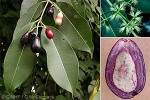Cook Islands Biodiversity Database
Species Page
Syzygium cumini
PistatiJambolan
Multimedia & Additional Resources
| Type | Description | Download |
| Leaves and fruit (whole and open) | 56KB |
General Information
Cook Islands Distribution
| Southern Group: Present Makatea: Present | ||||||||
RR |
MG |
AT |
MK |
MT |
AK |
PL |
TK |
MN |
++++ |
++++ |
++++ |
++++ |
++? |
+++ |
- |
- |
- |
| Northern Group: - | |||||
TN |
MH |
RK |
PK |
NS |
SW |
- |
- |
- |
- |
- |
- |
Scientific Taxonomy
Syzygium cumini Linnaeus
SYNONYMS: Myrtus cumini; Eugenia cumini; Eugenia jambolana [incl. GW]; Syzygium jambolanum
TAXONOMY: PLANTAE; ANTHOPHYTA (=Angiospermae); MAGNOLIOPSIDA (=Dicotyledones); ROSIDAE; Myrtales; MYRTACEAE
More Information
SIGNIFICANCE NOTES -
POSITIVE SIGNIFICANCE: Food (Fruit 2+). Comments: Elsewhere extracts of leaves and fruit are used to treat diabetes mellitus; and the fruit is used to treat chronic diarrhea.
NEGATIVE SIGNIFICANCE: Invasive - serious, Weed - serious. Comments: A widespread and persistent tree on horticultural land, and spreading widely in the mountain forest of Rarotonga. Difficult to control and very damaging to the growth of nearby plants.
IDENTIFICATION: Multi-trunked tree to 20m. TRUNK usually multiple. LEAVES opposite, green with conspicuous yellow midrib; oval to narrow-oval, to 20x8cm; edge smooth; tip drawn-out, sharp; stalk 2cm. FLOWERS open cluster to 10cmØ; each 15mmØ, petals 4 white, 4mm long; stamens ~100, to 6mm long. FRUIT berry, to 3x2cm, pear-shaped, ripens dark purple (March-April); flesh pink and tart; terminal cavity 3mmx3mmØ. SEED ovoid, to 1.5cm.
GENERAL NOTE: Native India-Burma. English names Jambolan and Jambol derived from Indian name Jambula. It was a very ancient introduction throughout Asia, Indonesia and Philippines, and is now circumtropical. It was established in Hawai‘i by 1870, introduced to Tahiti in 1880, and was common on Rarotonga by the 1920s and known as Ka‘ika papa‘ā, but it was not recorded by Cheeseman in 1899. It was planted extensively as windbreaks around orange plots during the 1940s and '50s.
The present unusual Rarotonga name of Pistati / Pistat comes from the unusual Tahitian Pistas, derived from French Pistache / Pistachier. The Pacific French use of Pistachier may have arisen from a misidentification of the Jambolan (Fr. Jamelonguier) as the Pistachio (Fr. Pistache / Pistachier). Maclet & Barrau (1959) wrote that the "jamelonguier is improperly called pistache in Tahiti" supporting the idea of a misidentification. Today in Pacific French the Jambolana is called Faux Pistachier, "False Pistachio". Alternatively, Pistache might have been derived from "pisse+tache", literally "pee stain", referring to the staining nature of the juicy fruit. [J-Y Meyer, pers.comm.1/2003, and various sources]
Vouchers & References
Vouchers:
None Recorded.
References:
p.975 Wagner et al.- Flowering Plants of Hawaii
p.636 Neal - In Gardens of Hawaii
p.1092 Hortus 3rd
p.1136 Royal Hort. Soc. Index of Garden Plants
p.3/327 A.C.Smith - Flora Vitiensis Nova
p.81 Wilder - Flora of Rarotonga
p.391b Whistler - Ethnobotany of the Cook Islands
p.102 McCormack/Kunzle - Rarotonga's Mountain Tracks and Plants
Data Update History (information):
zTX, zB02, zM02, zD02
Web Resources
Citation Information
McCormack, Gerald (2007) Cook Islands Biodiversity Database, Version 2007.2. Cook Islands Natural Heritage Trust, Rarotonga. Online at http://cookislands.bishopmuseum.org. ![]()
Please refer to our use policy.

